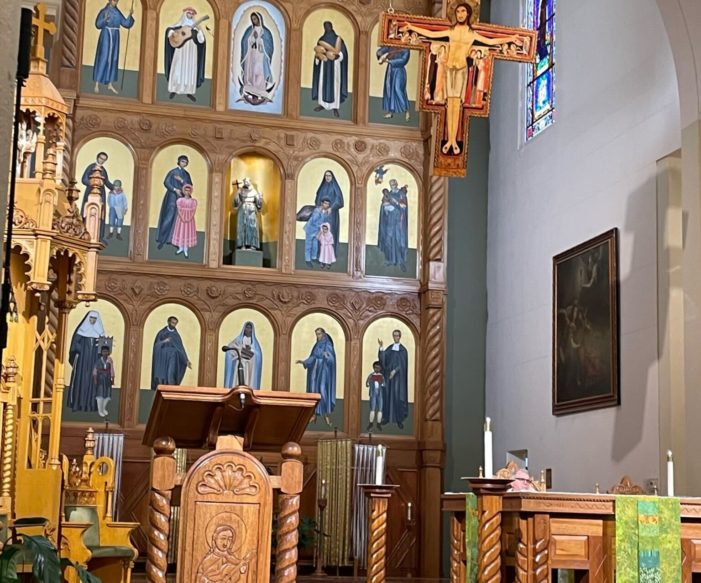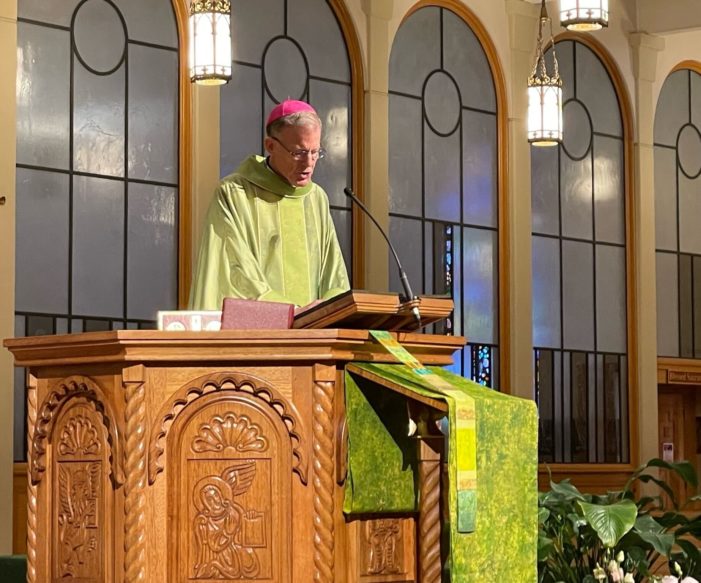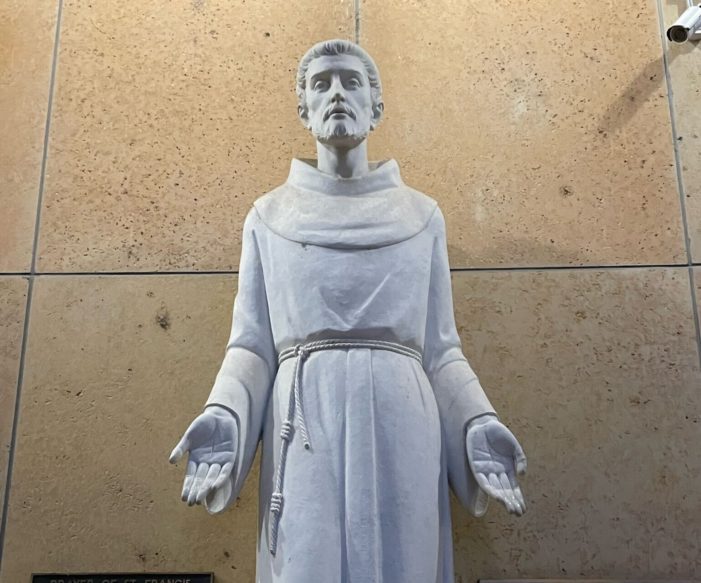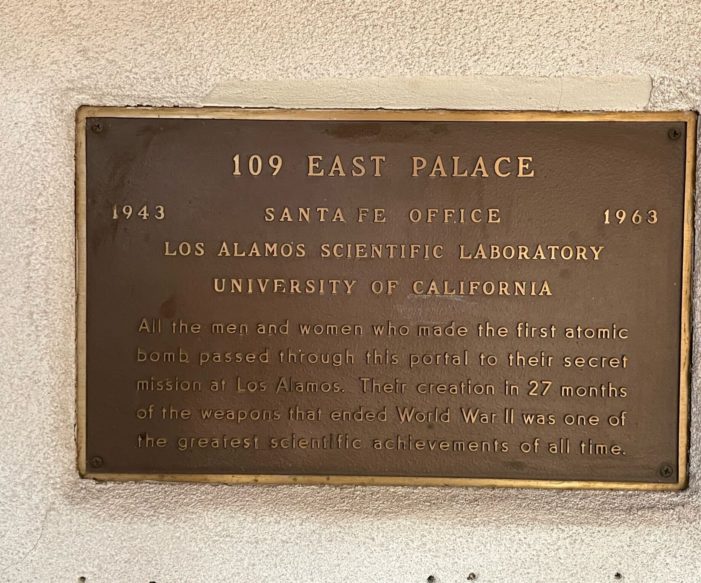“Jay [Coghlan] of Nukewatch, invited by Wester to answer an audience question about Ukraine having lost deterrence when it returned Soviet nuclear weapons to Moscow, emphasized that Ukraine never had the controls to actually detonate nuclear weapons stored on its territory. Coughlin then echoed Beamont’s statement, saying ‘we can flip the argument, say that Russia is shielded from consequences because it has nuclear weapons. Deterrence has been flipped on its head.’”
BY: KELSEY D. ATHERTON, INK STICK MEDIA | August 10, 2022 inkstickmedia.com
At least 100 parishioners must have been in attendance at the special mass at the Cathedral Basilica of Saint Francis of Assisi on Aug. 9, 2022. The Tuesday afternoon service at the historically significant church did not fall under the usual schedule. Following an afternoon rich in monsoon thunderstorms, the clouds cleared, allowing regulars and visitors alike to file in to hear what, exactly, the Archbishop of the Santa Fe Archdiocese had to say about the work of peace.
“In the way that 109 East Palace was the gateway to nuclear oblivion, I hope that the Basilica of St. Francis can be the gateway to global nuclear disarmament,” John C. Wester, Archbishop of Santa Fe, told the assembled crowd.
The address is instantly familiar to those fluent in nuclear history and opaque outside of it. During the Manhattan Project, the US effort to develop and build an Atomic Bomb in Los Alamos, 109 East Palace was the place to arrive before being covertly whisked away to the lab.
WHEN IT COMES TO SALVATION FROM NUCLEAR OBLIVION, FAITH IN THE RIGHTEOUSNESS OF THE TASK ALONE IS NOT ENOUGH. THERE MUST BE WORK THAT MAKES IT REAL.
It was the work of Los Alamos that made Aug. 9 the occasion for a mass dedicated to nuclear disarmament. On Aug. 9, 1945, the US dropped Fat Man, the second and so far last nuclear weapon used in war. The bomb fell on Nagasaki, a Japanese city hastily added to the targeting list. While the bombardier claims the clouds parted for visual confirmation of the target, it is at least equally plausible the crew decided to drop the bomb by radar targeting and fly back to base, instead of ditching it in the ocean or crashing on the way back.
When Fat Man hit Nagasaki, it killed an estimated 40,000 or 70,000 people. Wester consistently stuck to the high estimate i remarks, emphasizing both the real horror of the dropped bombs and the terrible scale of destruction existing weapons promise.
“For me, it’s the lethalness of them,” Wester told me in an interview the Friday before the special mass. “The absolute destructive power of warheads, of just one current modern day warhead of average impact is incredibly more powerful than those bombs dropped on Hiroshima, Nagasaki, 10,000 times more, incredibly more destructive,” he said. “And we don’t have just one, we’ve got around 13,000 nuclear warheads currently in the world today. The mind can’t really wrap itself around how destructive… it’s like trying to grasp what a light year is.”
The challenge of nuclear disarmament is partly a problem of scale. Russia is just shy of 6,000 warheads while the United States has about 5,500. The seven remaining nuclear armed countries possess a combined 1,300 or so warheads, with China the third most at a distant 350 and North Korea with the least at an estimated 20 warheads (and increasing). That is, all told, a fast decline from the global peak of over 70,000 warheads in the late 1980s, but it’s a number that’s increasing. Perhaps more importantly, it doesn’t capture the extent of the nuclear modernization efforts underway in countries like the United States and Russia, which are updating and remaking existing warheads into newer weapons.
“Every single human communication is fraught with error and misunderstanding. Well, that’s really scary when you consider a communication regarding launching a nuclear war between two major powers,” said Wester. “When God is in charge, I don’t worry so much, but when human beings are in charge of that kind of destructive power, I worry a lot.”
THE SANTA FE TALE
Against all of this, the Archbishop sets a church in New Mexico and the power of faith across religions to drive people to change the future of nuclear weaponry, starting with a special focus on New Mexico.
The city of Santa Fe, the Basilica, and present Pope Francis all take their name from St. Francis of Assisi, revered as an advocate of nature, peace, and the poor. In Wester’s “Living in the Light of Christ’s Peace: A Conversation Toward Nuclear Disarmament,” a booklet distributed after the mass, he makes special note of the sainted name.
“Ironically,” Wester writes, “the US government probably spends more on nuclear weapons within the boundaries of the Archdiocese of Santa Fe than any other diocese in the country and perhaps the world.”
Both Los Alamos and Sandia National Laboratories, as well as the Kirtland Munitions Storage Complex that contains up to 2,000 nuclear warheads, fall within bounds of the archdiocese. The atomic bomb was designed, built, and assembled in Los Alamos. At Sandia, atomic bomb design and production was refined. The Trinity Site is where the first nuclear bomb was detonated, its fallout plume creating in the downwinders the first nuclear victims, and it too falls within the geograpic reach of the Archdiocese of Santa Fe.
While the uranium mines of the Southwest fall more under the Gallup than Santa Fe diocese, the nuclear enterprise in the state is broader than just the highly compensated lab workers who specifically make weapons. Gallup sits within the Navajo Nation, home of the Diné people, and it is in these and pueblo lands that the burden of nuclear extraction has fallen most heavily. In a panel following the mass, former governor of Cochiti Pueblo Regis Pecos said, “We cannot be an energy colony for the rest of the country. Our Land of Enchantment cannot become the wasteland for our country.”
In a figure that Wester returned to in the mass, in the after-mass interfaith panel, and in printed material, the Department of Energy is spending $9.4 billion for nuclear weapons in New Mexico in 2023. The state’s budget for that year is only $8.5 billion.
That number is a specific and cherished rebuttal to lines of questioning about how much money the nuclear enterprise brings to the state of New Mexico specifically. That money is, at best, unevenly distributed, with the highly skilled and educated laboratory workers of Los Alamos county disproportionately well off, while New Mexico broadly remains a grim outlier for child poverty statewide.
Redirecting that spending toward other avenues, like schools, water resources, and wildfire protection, are part of a broader moral aim about how New Mexico can move beyond an economy oriented around engines of destruction. Pecos, emphasizing that spending and extracting for nuclear enterprise was an ideological choice, said “we must denounce the doctrine of discovery and manifest destiny” that make such a choice possible.
Another panelist, Reverence Dr. Holly Beaumont of the Interfaith Worker Justice-NM, said an economic assessment of the nuclear industry in New Mexico is incomplete without looking at the harms from testing, from poor nuclear waste management, and especially from uranium mining, which has taken a special toll on Diné and Pueblo people.
The arguments are structured as calls to win over legislators, for attendees to repeat and train friends on in an explicitly nonpartisan call to shift New Mexico away from its recent restart of nuclear weapons production to instead do the work of disarmament. As such, the panelists sometimes spoke at cross purposes on the topic of peace.
The panelists shared language on universal, verifiable disarmament, though one reason for disarmament was to change the kinds of wars that can be fought, rather than prevent them. Citing President Joe Biden’s caution in directly confronting Russia on Ukraine, Beaumont said nuclear arsenals are “preventing us from addressing Putin’s genocide. We cannot save our brothers and sisters because we are terrified of starting the next war.”
Jay Coughlin of Nukewatch, invited by Wester to answer an audience question about Ukraine having lost deterrence when it returned Soviet nuclear weapons to Moscow, emphasized that Ukraine never had the controls to actually detonate nuclear weapons stored on its territory. Coughlin then echoed Beamont’s statement, saying “we can flip the argument, say that Russia is shielded from consequences because it has nuclear weapons. Deterrence has been flipped on its head.”
FROM “TRINITY” TO THE PRINCE OF PEACE
If nuclear weapons permit the powerful to wage war on the weak, and prevent allies from coming to their defense, then what can be done to end the threat posed by the weapons? Wester, in homily, told the assembled congregation that with Pope Francis the Catholic Church has moved beyond a past conditional acceptance of deterrence, in part because no country is willing to commit to minimal deterrence. Arsenals of hundreds and thousands of warheads are built to wage nuclear war, not keep it at bay.
Asked, in our interview before the mass, if Wester expected lab workers to quit their jobs in protest, Wester said “I don’t expect somebody to quit their job, although I do think that individuals may in conscience feel they have to. But I’d love to see workers, engineers, nuclear scientists, at Los Alamos and Sandia starting to have conversations at lunch hour, at coffee, at the water cooler about this.”
With this call, the workers at the labs are to agitate internally, while retaining the skills that will be needed to dismantle nuclear weapons should the states with them agree to responsible dismantlement. The Treaty on the Prohibition of Nuclear Weapons is seen as one key stop on this work, as an existing and ready-made international agreement. Yet, no nuclear armed country voted for the Treaty.
If the argument feels rehearsed, it is because disagreement between bomb-makers and peace-makers within the church goes back decades. Wester cites Pope Francis directly, but “Living in the Light” follows in a long tradition of the church’s changed response to nuclear weapons. In 1980, the National Council of American Bishops set out to examine Just War doctrine especially as it pertained to nuclear weapons, and published three draft letters before a finalized one in May 1983. In the years between first and final draft, a group of Roman Catholics who worked at Los Alamos assembled “Nuclear Weapons & Morality: A View from Los Alamos,” a hundred-page rebuttal to the Bishops. “Nuclear Weapons & Morality” emphasized the strategic and moral value of deterrence, while calling for practical alternatives like increasing the strength of non-nuclear forces in Europe and of working towards truly verifiable multilateral disarmament.
The Bishops endorsed a limited version of deterrence, and like the Los Alamos group emphasized a particular moral and existential threat posed by the Soviet Union. But, the Bishops intended for the transformataive conversation on bombs to not just be left to the bomb-makers. Atomic weapons are a moral question that transcends the ability to describe how plutonium pits make a thermonuclear bomb thermnonuclear (though Wester’s “Living in the Light” contains a diagram explaining just that.) The Bishops ended the letter’s summary with “In making these judgments we speak as moral teachers, not as technical experts.”
This internal yet highly public Catholic debate took place before the close calls of the 1980s. Both Stanislav Petrov’s false alarm and the near-miss nuclear concerns around Able Archer came after the final draft of the Bishop’s letter. The total peak of nuclear warhead development was still five years in the future from 1983, and the rapid scale of the disarmament work that would follow seemed the kind of miraculous change one could anticipate only through faith alone.
It is in this tradition that Wester emphasizes an end to nuclear weapons coming from dialogue, not worker action.
“I think that in a microcosm, what we’re doing by bringing different faiths together on this question is to demonstrate that we can break down the barriers that divide us,” said Wester. “We talk a lot in our Catholic tradition of living in a world without borders, that in God’s eyes, we’re one human family living on one common earth, one common home together.”
As I sat in the pew watching the panel, what I felt most was familiarity. The structure of the arguments, the calls to shared humanity and shared responsibility for the future, were familiar across settings in the religious left circles in which I grew up. As was the gray hair of the attendees, the historic references were fixed firmly in actions taken during the 1960s. The horror of nuclear weapons remains clear, along with the complexity of getting multiple countries to agree to possess fewer of them.
In the shadow of the Sangre de Cristo mountains, I hoped that the moral clarity of the weapons would bring new blood into the work of disarmament. What I saw, instead, was a dedicated group of dutiful stewards, tending to an old familiar battlefield one more time. It is impossible to build a movement without dialogue, without some call to rethink the existing world and how it might be remade in a more just fashion. When it comes to salvation from nuclear oblivion, faith in the righteousness of the task alone is not enough. There must be work that makes it real.
Kelsey D. Atherton is a defense technology journalist based in Albuquerque, New Mexico. His reporting has appeared in Popular Science, C4ISRNET, and The New York Times.
Pictures in the body of this piece were taken by Althea May Atherton.





